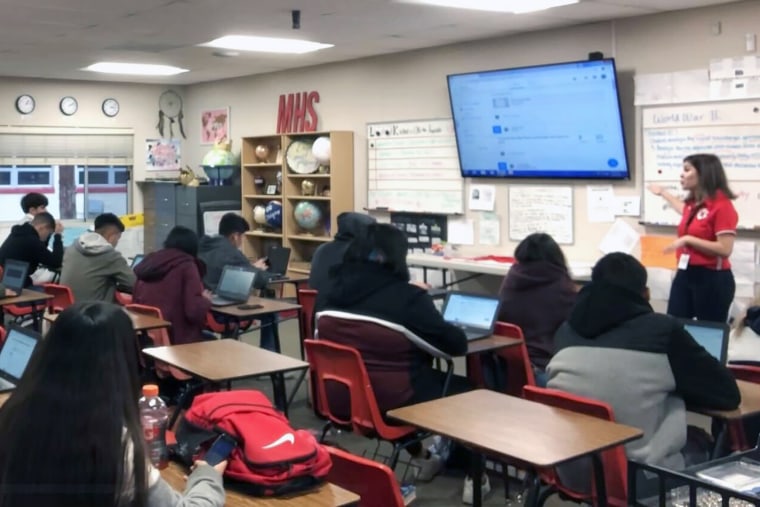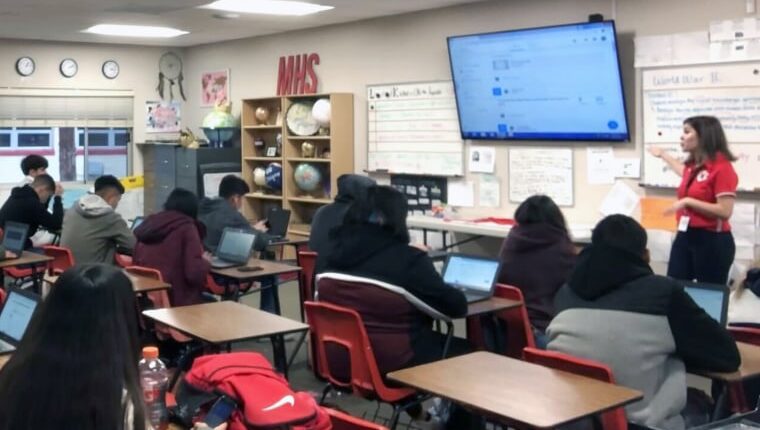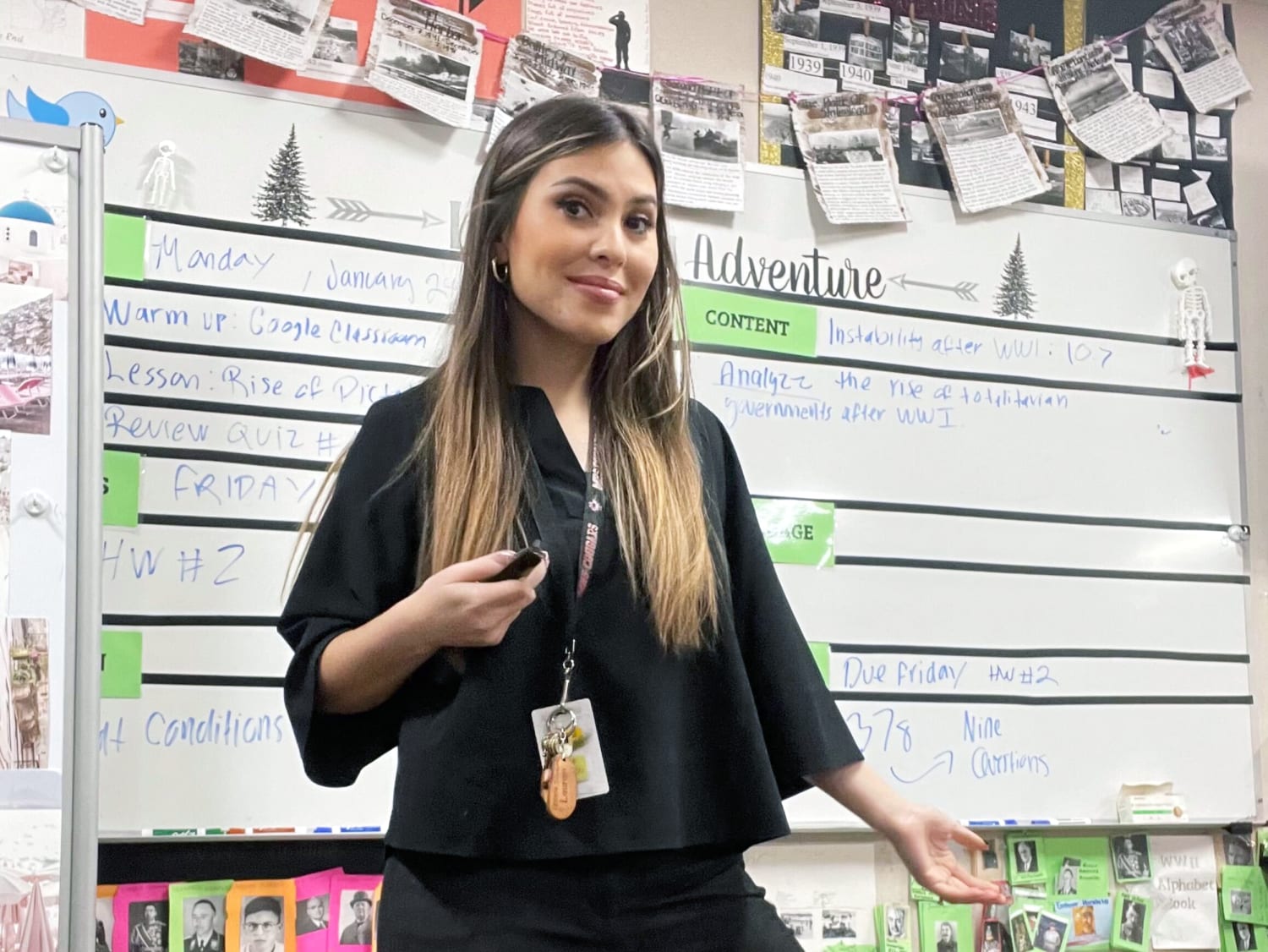Aimee Preciado has been participating in her local Cinco de Mayo celebrations in McFarland, California, for almost a decade now. For a long time she thought the Mexican holiday celebrated the country’s independence.
“I just never thought too deeply about it,” said Preciado, 17, a junior of Mexican American heritage at McFarland High School.
She learned more about the history and significance of Cinco de Mayo when she viewed a video on TikTok posted by her world history teacher.
“So it’s May 5, 1862, aka Cinco de Mayo and the French are about to mess around and find out,” Lauren Cella, who teaches 10th grade world history at McFarland High, said in a TikTok post that’s since gathered more than 530,000 views. “In 1867, Mexico drives out the French and [Emperor Maximilian] gets unalived via firing squad and Mexico stays independent. Preguntas?”
Cella, 30, who is of Mexican, Puerto Rican and Chinese heritage, has gathered more than 146,000 followers on TikTok for her content that explains world history through a Gen Z lens, including the latest slang, expressions and references to pop culture and trends. Her video on Cinco de Mayo had elicited more than 1,000 comments as of Thursday.
“You make this so much more interesting,” one TikTok user commented, while another said it was the first time in their 49 years of life that they understood what Cinco de Mayo was about. Another added how they “learned more in a 2-minute or less TikTok video [compared] to a year of Latin America history class.”
Cinco de Mayo is often associated in the U.S. with margaritas, beer, food and cultural celebrations. But unlike Mexico’s Independence Day, which is celebrated on Sept. 16, Cinco de Mayo commemorates the triumph of the Mexican army over the French army — which was considered the world’s strongest army at the time — at the Battle of Puebla on May 5, 1862.
“There is just such a lack of awareness in the United States about history, world history, especially from other cultures or traditions,” Cella said. “Even amongst the Mexican community, I think there’s still some confusion about where Cinco de Mayo comes from.”
The Cinco de Mayo celebrations are actually much bigger in the U.S. than in Mexico. Over time the holiday in the U.S. evolved and became more commercial, as companies began promoting Cinco de Mayo in the 1980s and 1990s to reach more Latinos and other consumers of tequila and beer.
Ties between U.S., Mexican history overlooked
Mexican and American histories are intertwined, and something often overlooked is the fact that it was Gen. Ignacio Zaragosa, a Texan born in what is now Goliad, who led the Mexican forces to victory over the French.
“This fact should make Americans, especially Texans, very proud of their connection to that event,” Raul Ramos, of the University of Houston, told NBC News in 2016. “But often it doesn’t resonate. The Mexican aspect of Texas history has been so marginalized and ghettoized, it takes extra effort for people to learn about it.”
In Cella’s classroom, most of her students are Latino. When her students say they don’t particularly like history, she takes it on as a challenge. Cella’s presentations and lectures differ from her TikTok videos online in that they are more traditional and in-depth than the 60-second clips she posts. But she’ll occasionally use words that are more relatable to her younger students.

“The way that kids learn now with technology and their attention spans — you have to be able to relate it. You have to be able to break it down, and eventually, the academic vocabulary will come,” Cella said. “I do have to stay up to date with all of the lingo and the culture and the trends … even if I don’t want to. I’m surrounded by teenagers.”
“She would say things in a tone that was easy for us to understand, easy for us to grasp, and we weren’t bored. Like, I’ve never been bored a day in her class,” Preciado said.
“She’s putting history in Gen Z’s words, basically, you know; it’s more appealing to us. We don’t want all the official stuff. We want more of the simple — the way she uses more of our slang, in a sense,” Lucas Rodriguez, 17, a senior in her journalism elective class, said.
Cella said her students have found her TikTok videos and they’re her biggest supporters. “I’m sure it’s so cringy but it’s OK, I just embrace it. I am very, very lucky to have an amazing department and administration who is very supportive.”
Most of the comments she gets online are actually from adults, she said, recounting how they didn’t learn or retain much history in school. She attributes learning falls through the cracks to the pressure teachers face to meet state testing and standards.
Despite her efforts to offer relatable, bite-sized history lessons online, she’s received some criticism from commenters who deem her content too condensed.
“You can’t tell the whole story in 60 seconds. The goal is to spark an interest and an understanding. And what I think is really cool, if you go to the comments, is people will, like, add things … They’re basically having this conversation, this class discussion in the comment section,” Cella said.
“I think the approach has obviously resonated with people on the internet. And I’m really still very shocked that this many people care about history and are excited, and it’s really fun,” Cella said.
Source: | This article originally belongs to Nbcnews.com










